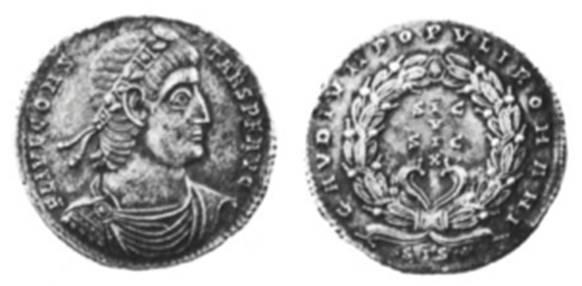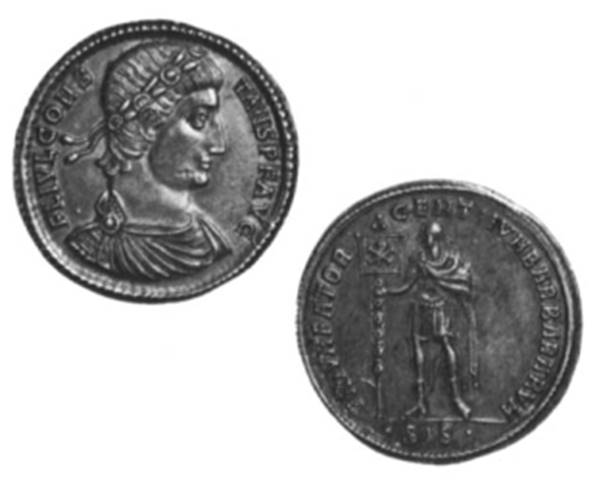Medallion of Constans. Siscia, Yugoslavia, 337-338. Silver. Medallion of Constans
obv: FL(avius) iVL(ius) constans p(ius) F(elix) AVG(ustus). Bust of Constans facing right diademed, draped, and cuirassed. rev: gavdivm popvli romani. sic/v/sic/x in four lines within laurel wreath; in exergue, sis- (sis[cia] plus issue mark)
Like nos. 35, 36, and 37, this medallion was struck to commemorate the fulfillment of one set of vows and the undertaking of another. The piece is an early illustration of the tendency away from elaborate celebration of that essentially pagan ritual: although the “joy of the Roman people" is proclaimed on the reverse, there is no elaborate or symbolic type, and even the normal formula "votis v mvltis x" is simplified to "sic v sic x." The emphasis is on the general wellbeing of the individual rather than on the importance of the occasion.

The portrait is similar in conception and technique to that of no. 37, with which it is nearly contemporary; but an even heavier emphasis on the eyes lends greater force to this- rendering. Two aspects of the portrait anticipate later developments: the elongated features, which suggest remoteness, and the tendency toward frontality evident in the forward thrust of the left shoulder.
Formerly in the Adra M. Newell collection.
Medallion of Constans. Siscia, Yugoslavia, 347. Silver. obv: FL(avius) iVL(ius) constans p(ius) F(elix) AVG(ustus). Bust of Constans facing right, wearing diadem, cuirass, and paludamentum fastened at shoulder with a jeweled brooch. rev: trivmfator gentivm barbararvm. Constans in military garb holding reversed spear in left hand and in right a legionary standard bearing the christogram. In exergue, -sis- (sis[cia] plus issue mark)

This type was widely struck and undoubtedly commemorates Constans' successes in his campaigns against the northern barbarians, which began about 340. The posture of the emperor with a military standard is not unusual; but the addition of a christogram, albeit in a subordinate position, is an overt suggestion of divine involvement in human affairs, and is an early example of the gradual emergence of Christian symbolism on the coinage. The "Triumphator" type would not become common on coins for some years, but was a favorite on medallions (cf. no. 43).
The portrait is completely in the Constantinian style and is a magnificent example of the imposition of the Hellenistic ideal upon the rude features of Constans.
Formerly in the Hayford Peirce collection.
Date added: 2025-07-10; views: 140;
